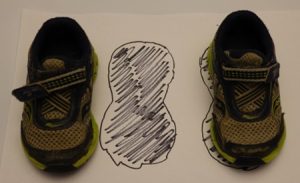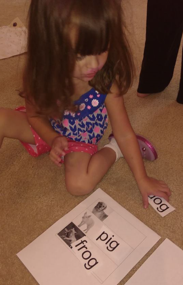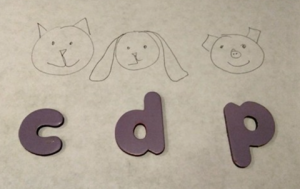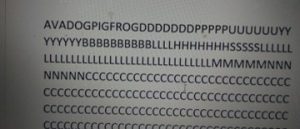Hello !
I’m so glad you checked this page out. Teaching a child to read is often regarded as a stressful, hair-pulling exercise and it need not be. I give a very straightforward summary of my minimalist approach to reading here: Get Off the Phonics Train Early: Moving to Functional Reading After Phonics.
In short, I do indeed do (hands-on) phonics lessons (with movable letters mostly). But if we are reading any word, I just say it. These two things, straightforward phonics lessons and just saying words as you encounter them, make learning to read a joyful, not hair-pulling exercise that parents can do with their children. And I do advocate parents be involved in teaching their child to read. The attached relationship they have with you is powerful.
Some are opposed to early reading lessons. But with hands-on assists, a straightforward approach, and loving parents, there is no need to fear teaching children to read. I argue the problem isn’t that children aren’t ready. It’s the approach. We ask too much of the cognitive portion of children’s mind when we ask them to sound out every letter as they see words. We are unfair to that part of the child’s mind, asking them to dissect purely symbols, void of context or relevance. See Get Off the Phonics Train Early.
I offer the basic approach in the above article. Below are some broken down activities to help understand and facilitate any given reading lesson.
Reading Activities
- Vocabulary Builder
- Learn Letters
- Learn Letter Sounds
- Tying Letters to Words
- Stringing Letters to Make a Word
- Attach Words to Objects
- Functional Readers
I don’t think you’ll necessarily need to do all of these lessons. If you are working with a very young child (under 3), there are a lot of assists below to string them along. If you are working with an older child, you may not need to do all of these activities. You might also cater them to your unique child. For instance, if you have a very active child, they might like hopping from one letter to the next as drawn on the floor rather than working with their hands.
I always advocate that you present a lesson and if they aren’t interested, put it away. And put it away for months. There is no rush and everything can change in 6-12 months. If they are interested, by all means!
The main thing is that they eventually see that letters make up words. I recommend a set of movable letters to aid in this, with all colors being the same except that vowels and consonants may be different. A tray to hold the letters is quite convenient. A hands-on manipulative like movable letters is a great assist for a child.
Ultimately we just want them to see that words are made up of letters, which sound a certain way. If your child shows that, imo, they are now a reader.
Video #1: A Vocabulary Builder
Toddler Milestone 1: Language Explosion
Age: 18 months
Lesson: Vocabulary Building
Picture Books
A great activity when they are entering a language explosion is to build the child’s vocabulary with picture books. There are many picture books on the market which feature clear pictures of a variety of objects usually with the word printed next to the picture. An example is First 100 Words by Roger Priddy. I like to have at least one general picture book and one of just animals. You can expand this by getting books that feature one type of object, such as a picture book of flowers or whatever else is important to you for your child to learn. You can do body parts by simply pointing to you or your child’s body parts.
There is an art to presenting new words. I used the three stages of learning as presented by Maria Montessori. The first stage is for instance simply pointing to a picture of a horse and say “horse.” Stay at this stage for at least one day. You can point to as many pictures as you like. Simply enjoy the picture book and tell your child what the pictures are without asking any questions of the child.
Stage two is asking the child “Which one is the horse?” For this, I first use stage one by pointing, in this example, to the horse, and then immediately after this, I ask “Which one is the horse?” If the child cannot answer, you might try another picture, but for the exercise related to the horse, go back to stage one and don’t ask what it is again until the next day. If they do answer correctly, you might ask what other pictures are, stopping when they seem to tire of the activity. This question at stage two is easy on purpose. It is also essential to learning as a person needs to use information for it to “stick.” Humans learn well by touching things, and I found that if the child touched the picture of the horse after being asked to find it, it was as if the idea of “horse” were being downloaded into their brain.
Stage three is to point to a picture and ask, “What is this?” They then respond with “horse.” If they can’t answer, return to a previous stage and try again the next day. As they say “horse,” they are practicing enunciation as well.
I often jumped around in stages when reading with my children, perhaps going to stage three with pictures they were comfortable with and scaling back to stage one with others they weren’t comfortable with during the same reading session. At all times if I went further or scaled back was dependent on their answers and enthusiasm. Once they reach the third level of knowledge, they have mastered the idea.
Video #2: Learning Letters
Toddler Milestone 3: Symbolic Thought
Age: 22 months
Lesson: Learning Letters
There is a slight trick to learning letters at this young age, explained with these two activities.
Concrete to Abstract Matching Games
A great activity is to match a concrete object a drawing of that object. An example of this is to match a Cinderella doll to a picture of Cinderella. This is an important pre-reading activity. You show the child that the symbols and pictures in books mean something You can make many activities like this for teaching purposes as well, such as matching different model airplanes to their picture in a book, which helps the child to differentiate the types of airplanes.
To do this in a way that the concrete object and drawing are exact, you can take a knobbed shape puzzle, which has puzzle pieces of a square, oval, etc., and then trace the puzzle pieces on a piece of paper. It will be easier for the child if you color these shapes in. The child then, for instance, places the square puzzle piece on the square on the paper. These activities are what Maria Montessori called moving from concrete to abstract.

Letter Puzzle
To teach letters, I used a simple wooden letter puzzle and the three stages of learning. The puzzle is nice as there is a strong physical boundary and the child must orient the letter correctly. I did this coinciding with or after doing other concrete to abstract activities (e.g., a Cinderella doll to her drawn picture.) I found teaching letters was different than teaching words. A letter is an abstract symbol as opposed to an object like “horse.” I found that the concrete to abstract activities helped to teach letters.
I taught letter names first, not sounds, which is different than is done in The Montessori Method. I found it too awkward to try to teach sounds initially. I also did it this way because the child can better learn letters by singing the Alphabet Song after completing the puzzle. The Alphabet Song acts as the control of error as they point to letters and sing, “A, B, C, D …“
I taught letter sounds later, and my children didn’t have a problem grasping that a letter was named something but “said” something different when used to read. Children know a cow is a “cow” but says “moo” and similarly they can understand A is “A” and “says” “ahh.”
I also did not worry about whether I taught lower or upper-case letters first. It is true that most letters in books are lower case. However, some of the first words they might be interested in are typically in all upper-case letters, such as how the word “POP!” might be found on a page in a book. I found that at the milestone of Memory Expansion a child can retain all lower and upper-case letters and their sounds.
I also liked to match movable letters to large images of letters in a book. This facilitates drawing children in to the book and gives relevance to the letters they see.
Video #3: Letter Sounds
Toddler Milestone 4: Memory Expansion
Age: 23 months
Lesson: Learning Letter Sounds
Phonics Island
We introduced a tablet at this milestone. I found great value in electronic devices. They can keep up with a child longer than I can. You can put only what you are comfortable with on the device. Using it to teach letter sounds is one example of where an electronic device really shines. We used an app called Phonics Island. It simply asks the child to pop a balloon that sounds like [whatever letter sound]. I found a tablet could keep up with a child’s desire to do this a lot longer than I could. The child needs to have done the concrete to abstract activities as described previously (in the milestone of Symbolic Thought) in order to understand what letters are before using the app. There is also a Memory Game in Phonics Island, where cards are turned face down and the child finds matching letters, that I found children can do surprisingly well at this young age. On Phonics Island, there is also a tracing letters activity the child can do. At this milestone, with such a big memory increase, the child can learn all 26 letters and their letter sounds. Phonics Island also helped to teach my children both upper-case and lower-case letters.
I would sing “The ‘A’s on the bus go ‘ah ah ah’ … just like ‘ant’” to reinforce that “A” is the name of the letter but “ah” is the sound of the letter, when they learned letter sounds.
Video #4: Tie Letters to Words
Toddler Milestone 6: Decision Making
Age: 2 years, 2 months
Lesson: First Letter of an Object
Match the First Letter of an Object to the Object
Matching a movable letter to an object whose name starts with that letter is something that you can do at this young age now that they can make a decision. I found my daughter did not do this for another month, but, given that children can make a decision starting at this milestone, I believe this is the earliest they may be able to do this.
The first thing you will need are movable letters. I cannot stress enough the importance of having an organizer for the letters. It lays out the letters nicely for the child to get and brings a lot of clarity to the activity. I did not have an organizer when I did this activity with my first child, but I had obtained one by the time my second child was this age, and it made a big difference. Plastic letter tile organizers exist and are much less expensive than wood. It is ideal that the letters are the same color. I wish manufacturers would stop making letters and other things multi-colored. We bought a set of magnetic letters and then spray painted them such that the consonants were purple and the vowels were yellow. Most letter tile organizers come with letters. I would recommend buying them as a package.
Identifying the first letter of a word is the easiest step for a child to start building words. The easiest activity to do with a child is to find the most simple, clear, vivid book you can find that has a letter and a word that starts with that letter next to it. Nothing compares to Dick Bruna’s b is for bear. This book is no longer in print but used copies are available from online sellers. On the first page of this book, there is an “a” and opposite of this is a bright, clear apple—and that’s all there is. Point to the “a” and say “aah” and point to the apple and say “apple.” “aa, apple.” “bb, bear.” “cc, castle.” There are two things you say per page, and that is it.
The next activity is to grab a movable letter and match it to its letter using the same book you used for the previous activity. This is so easy. Right? It gets the child used to selecting a letter from the organizer and then putting it back. Doing all 26, which is quite a lot, in alphabetical order makes it easy for the child to know where the letters go. In doing this easy matching activity, they are noticing thoroughly how “bbbb” is the first part of “bear.” Getting to this point is huge. The child can see the connection between the letter and the sound in the word. I like to use a book for this especially (as opposed to a hand-made activity), because it, like previous reading activities described, draws the child into books. Hearing a letter sound while saying a word with the sound might help your child identify them better. Trying to make an isolated “b” sound is hard. It’s always “buh,” not “bbbb.” This activity is simultaneously stage three of retrieving a letter sound, and stage one of introducing the idea that words are made up letter sounds.
For stage two, the child is put to a harder test. Here is the easiest activity you can do. Get three letters and objects which match those letters with the first letter of their name. The child then matches the three letters to the objects. This should be very easy at this point, but a nice, healthy challenge for them. Give a demonstration of this at first and don’t ask the child to do the lesson until the day after the demonstration. My daughter could do this handily at 2 years, 3 1/2 months.
If working with a word whose first letter sound is not represented by the typical letter sound, go with what the first letter of the word sounds like. For instance, giraffe would match with “j.”
Matching games using books are also ideal where you match for instance “s” to Cinderella’s picture.
You do your child a great favor by staying with these activities for weeks. I find children have trouble finding the second letter of most words, such as the “a” in “cat.” I propose this may be because vowels are harder to differentiate than consonants. “K” and “M” sound a lot different from each other than do “E” and “I.” So, work on every single letter possible until you are confident they can hear a letter sound and retrieve the letter. Do consonants first, and then work on vowels.
Video #5: Stringing Letters to Make a Word
Toddler Milestone 8: Sequence of Events
Age: 2 years, 7 months
Lesson: Stringing Letters Together Make a Word
Putting Letters in Sequence to Make a Word
Now that the child can put things in order better, putting letters together to make a word is an ideal activity. As always, give an easy assist to help the child. I had a book with a word and its picture with it. I then had my child spell out the word, using movable letters, while having the word right in front of him to help. This is the first stage of stringing a word together.

A great way to go to stage two is to use Microsoft Word or any other word processor and let children make up their own words. At first, they probably make up nonsense words—remember, misbehavior is growth! I find in time they start spelling actual words. I was greatly surprised when my daughter did this activity completely by herself that I found this:
Video #6: 3-Part Montessori Reading Lesson
Toddler Milestone 10: Mental Picturing
Age: 2 years, 9 months
Lesson: Attach Words to Objects
In making sure a child can read whole words, they can start to make decisions like which restroom to go in or which door to go out of (“Enter” or “Exit”?). They become functional readers with this approach.
Three-Part Montessori Reading Lesson
For reading, in order to know that “dog” matches an actual dog, children need to be able to read “dog” and be able to conjure in their mind a picture of a dog. Therefore, the imagination seen at this milestone (and which probably starts in subtle form in the last milestone) is necessary for this step in reading. Doing a three-part Montessori reading lesson is a great activity to facilitate this, assuming the child can spell out a few simple words now.
If you do this activity for the next several years, of simply putting a word next to its picture or on an object, you do your child a great favor. My son learned to read this way easily, and he found great joy in being able to figure out how to read new words based on the context clues, such as road signs or restaurant signs. Many educational apps, videos, and books provide pictures with words next to them. This is the easiest and most joyful way to learn how to read.

Beginner Books
Any beginner book can be used. I made a big mistake with my first child by demanding he read the words without much assistance from me. I changed my approach with him, and it was for the better. I had previously thought that if I read the book to him, he would memorize it, and then the educational value would be lost as he wouldn’t be sounding out the words. How wrong I was! My approach to beginner books is to read them with your children as often as they want and for fun. Then we talk about the pictures to understand the story better. I also act out the book as a play on occasion. Make it fun! Many beginner books list the new words at the beginning of the book. If so, we talk about the words at the beginning. I don’t make my children sound out the words. I point to the word and say what it is. The whole lesson should be fun and easy for both you and your child. I found my daughter would sometimes figure out words on her own. She once looked at words, and I could tell she was deep in thought, and she then, pointing correctly to the words, read the sentence, “Bob hits the tin can.”
Video #7: Knowing How to Read is Fun and Makes Them Feel Powerful!
Preschool Milestone 8: Integrates Principles
Age: 3 years, 5 months
Lesson: Funcational and Self Taught Reader
I do not yet have a book on preschoolers. In this video I talk about how children now know the mechanics of reading–that c-a-t says “cat”–and they also know the function of reading: that picking the door that says “Exit” is the right door if you are leaving. Now they put these two things together. They might stop in front of the word “Exit” and start to sound it out, “e-x-i-t.” Children become self taught readers at this point. They reverse engineer words. I explain more in the video.
Conclusion
Thanks for reading this far!! Please BOOKMARK this to come back to it and please SHARE it with friends and family! Thank you!!

